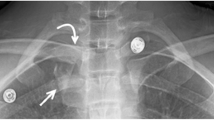Abstract
The standard radiographic series is not always sufficient to diagnose and characterize subtle musculoskeletal injuries. Missed or delayed diagnoses can negatively affect patient acute morbidity and long-term outcomes. Similarly, management based on erroneous diagnoses may lead to unnecessary treatment and restrictions. Body-part- or joint-specific supplemental radiographic views and stress radiography offer an alternative for further evaluation of subtle injuries in specific clinical situations and may obviate the need for the added cost and potential ionizing radiation exposure of further cross-sectional imaging. Familiarity with these complementary exams allows radiologists to play an important role in patient care, as their utilization can improve diagnostic accuracy, clarify subtle or uncertain findings, and direct timely patient management. This review highlights important supplemental views and stress radiographic examinations useful in the evaluation of emergent lower extremity musculoskeletal trauma.










Similar content being viewed by others
References
Khurana B, Sheehan SE, Sodickson AD, Weaver MJ (2014) Pelvic ring fractures: what the orthopedic surgeon wants to know. Radiographics 34:1317–1333
Campbell SE (2005) Radiography of the hip: lines, signs, and patterns of disease. Semin Roentgenol 40:290–319
Brandser EA, El-Khoury GY, Marsh JL (1995) Acetabular fractures: a systemic approach to classification. Emerg Radiol 2:18–28
Durkee NJ, Jacobson J, Jamadar D, Karunakar MA, Morag Y, Hayes C (2006) Classification of common acetabular fractures: radiographic and CT appearances. Am J Roentgenol 187:915–925
Garras DN, Carothers JT, Olson SA (2008) Single-leg-stance (flamingo) radiographs to assess pelvic instability: how much motion is normal? J Bone Joint Surg Am 90:2114–2118
James EW, Williams BT, LaPrade RF (2014) Stress radiography for the diagnosis of knee ligament injuries: a systematic review. Clin Orthop Relat Res 472:2644–2657
Lafferty PM, Min W, Tejwani NC (2009) Stress radiographics in orthopaedic surgery. J Am Acad Orthop Surg 17:528–539
Schulz MS, Steenlage ES, Russe K, Strobel MJ (2007) Distribution of posterior tibial displacement in knees with posterior cruciate ligament tears. J Bone Joint Surg Am 89:332–338
Sawant M, Narasimha MA, Ireland J (2004) Valgus knee injuries: evaluation and documentation using a simple technique of stress radiography. Knee 11:25–28
DiGiovanni BF, Partal G, Baumhauer JF (2004) Acute ankle injury and chronic lateral instability in the athlete. Clin Sports Med 23:1–19
Mansour R, Jibri Z, Kamath S, Mukherjee K, Ostlere S (2011) Persistent ankle pain following a sprain: a review of imaging. Emerg Radiol 18:211–225
Beynnon BD, Webb G, Huber BM, Pappas CN, Renström P, Haugh LD (2005) Radiographic measurement of anterior talar translation in the ankle: determination of the most reliable method. Clin Biomech 20:301–306
Dowling LB, Giakoumis M, Ryan JD (2014) Narrowing the normal range for lateral ankle ligament stability with stress radiography. J Foot Ankle Surg 53:269–273
Rijke A, Jones B, Vierhout P (1986) Stress examination of traumatized lateral ligaments of the ankle. Clin Orthop Relat Res 9:143–151
Van den Bekerom MJ, Mutsaerts EL, Niek van Dijk C (2009) Evaluation of the integrity of the deltoid ligament in supination external rotation ankle fractures: a systematic review of the literature. Arch Orthop Trauma Surg 129:227–235
Michelson JD, Varner KE, Checcone M (2001) Diagnosing deltoid injury in ankle fracture: the gravity stress view. Clin Orthop Relat Res 387:178–182
Donovan A, Schweitzer ME (2012) Imaging musculoskeletal trauma interpretation and reporting. Wiley-Blackwell, Chichester
Kaplan JD, Karlin JM, Scurran BL, Daly N (1991) Lisfranc’s fracture-dislocation: a review of the literature and case reports. J Am Podiatr Med Assoc 81:531–539
Potter HG, Deland JT, Gusmer PB, Carson E, Warren RF (1998) Magnetic resonance imaging of the Lisfranc ligament of the foot. Foot Ankle Int 19:438–446
Conflict of interest
The authors declare that they have no conflict of interest.
Author information
Authors and Affiliations
Corresponding author
Rights and permissions
About this article
Cite this article
Friedman, M.V., Chris, S., Baker, J.C. et al. Review of supplemental views and stress radiography in musculoskeletal trauma: lower extremity. Emerg Radiol 22, 589–594 (2015). https://doi.org/10.1007/s10140-015-1315-8
Received:
Accepted:
Published:
Issue Date:
DOI: https://doi.org/10.1007/s10140-015-1315-8




